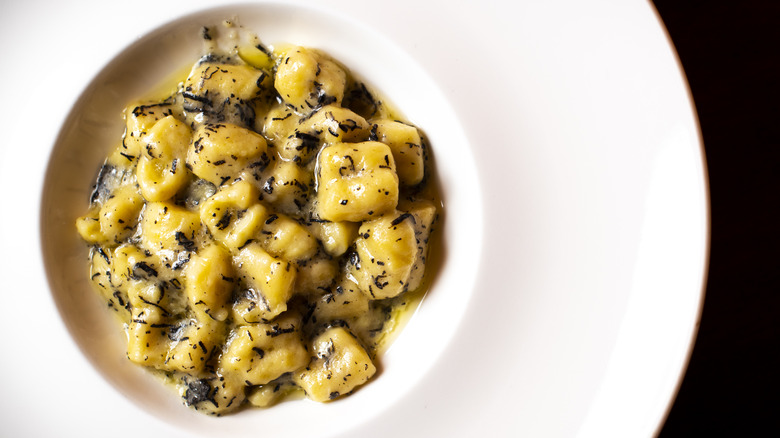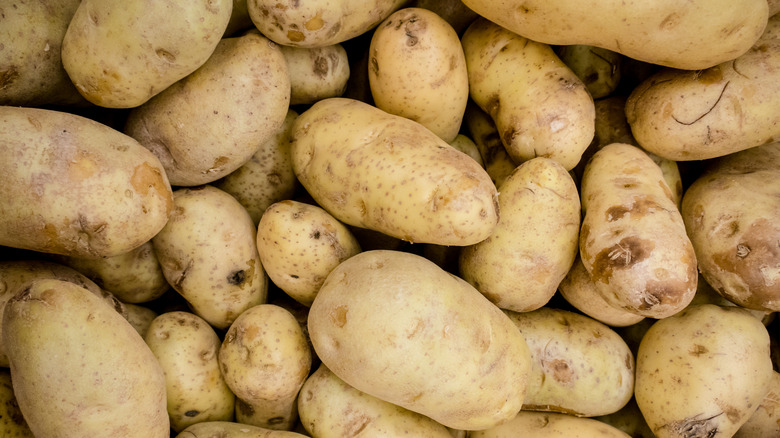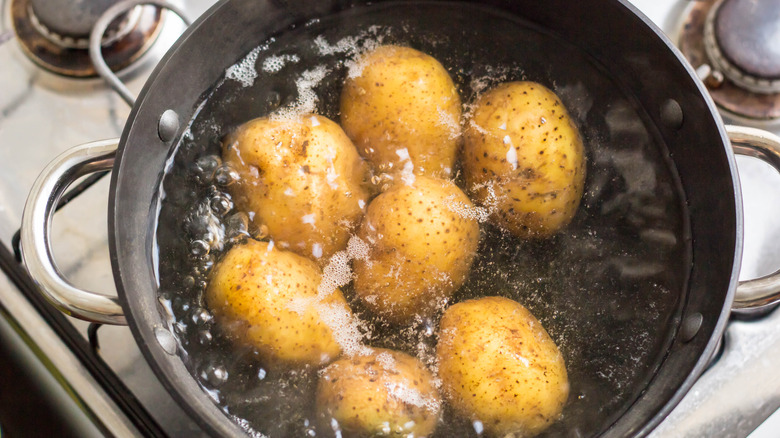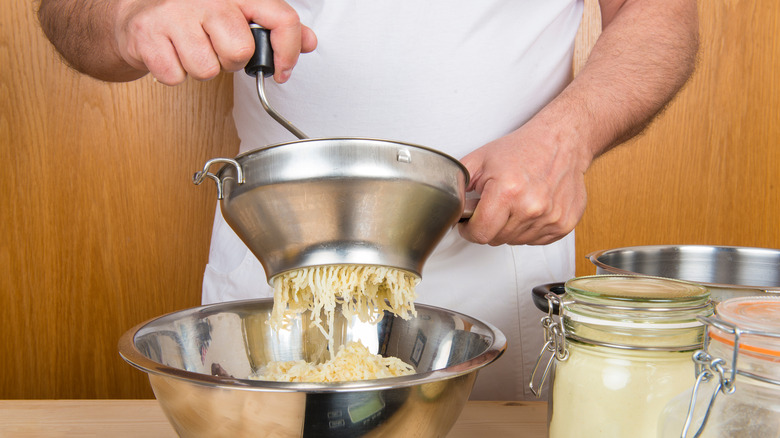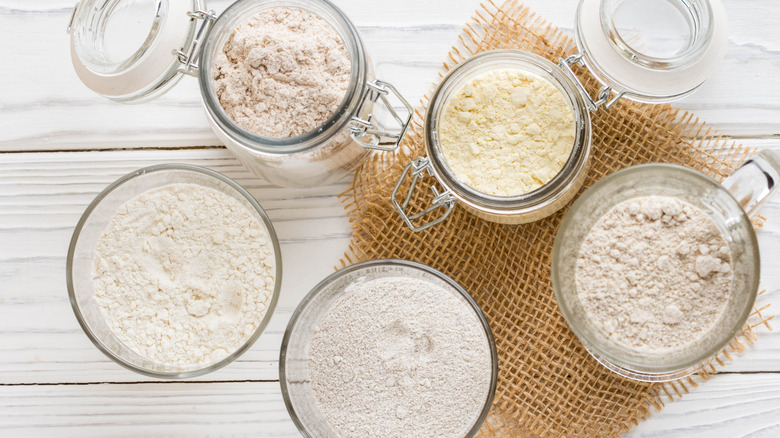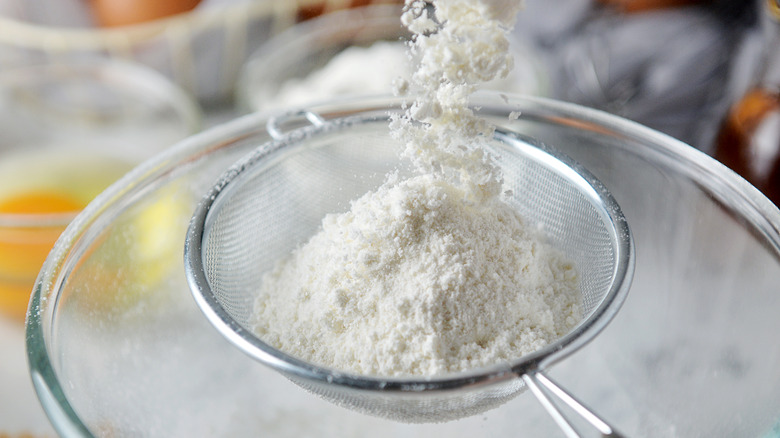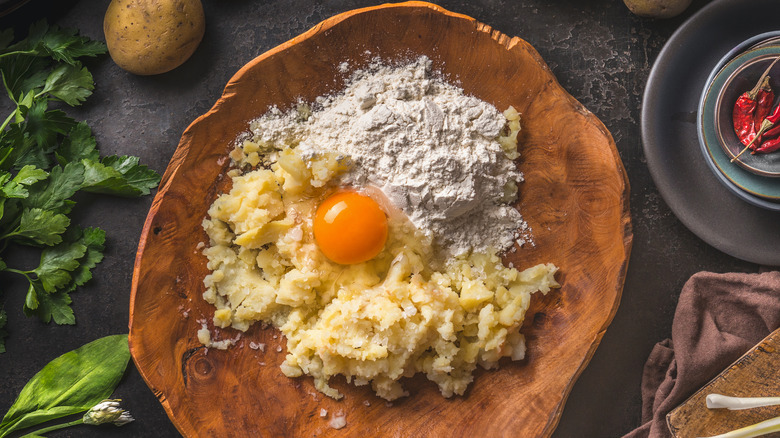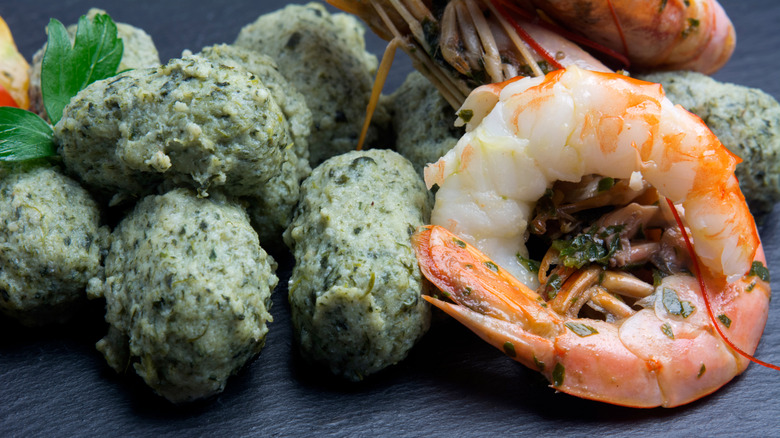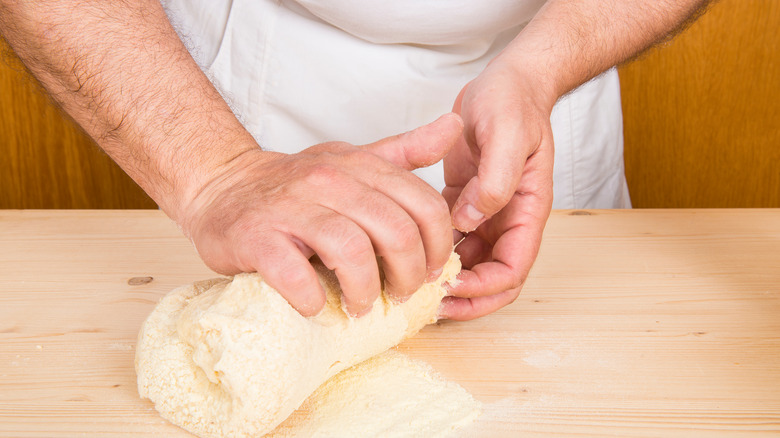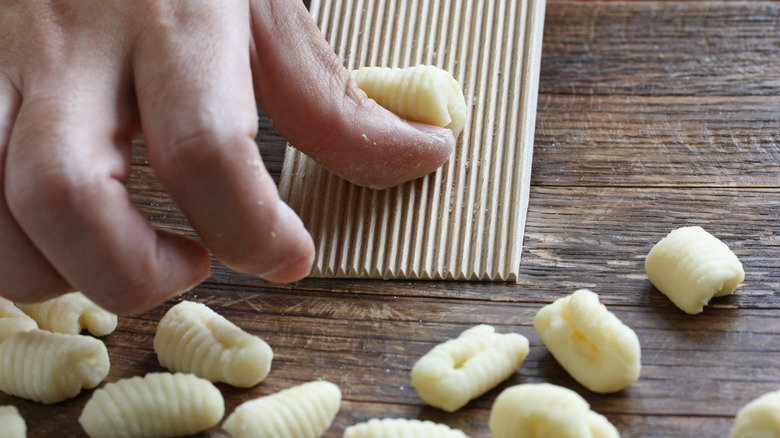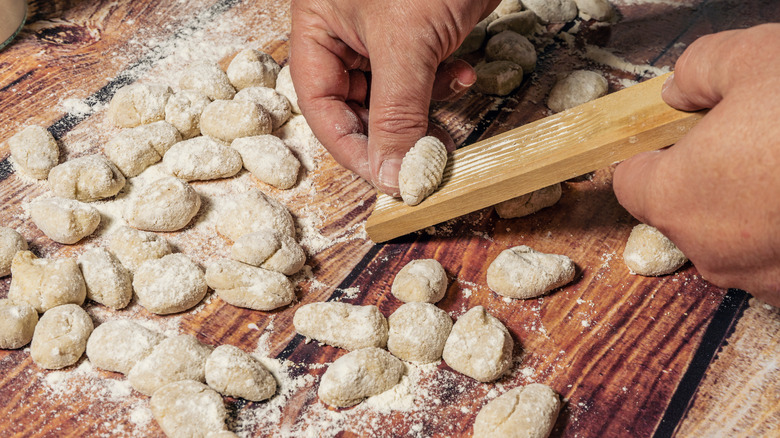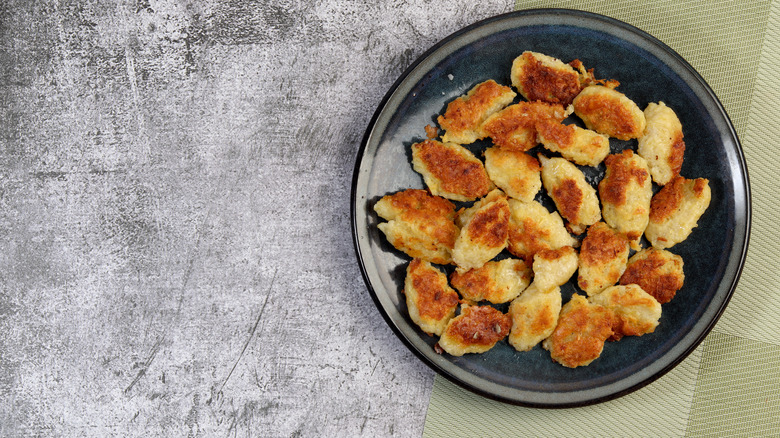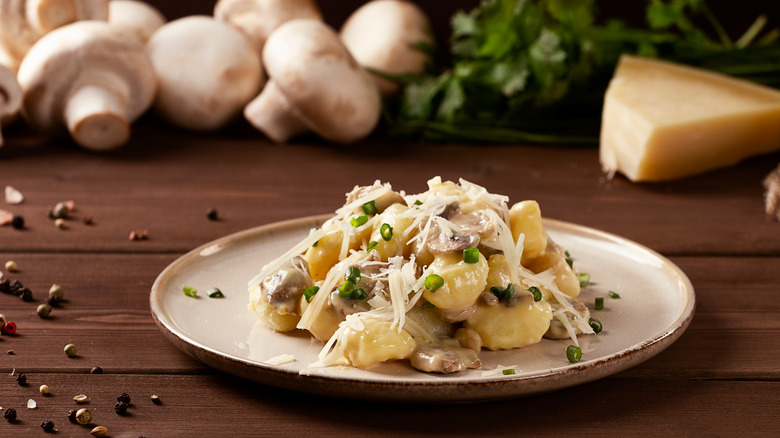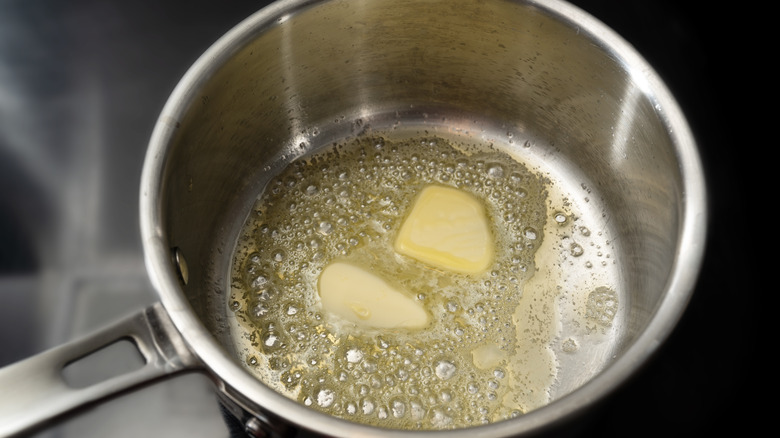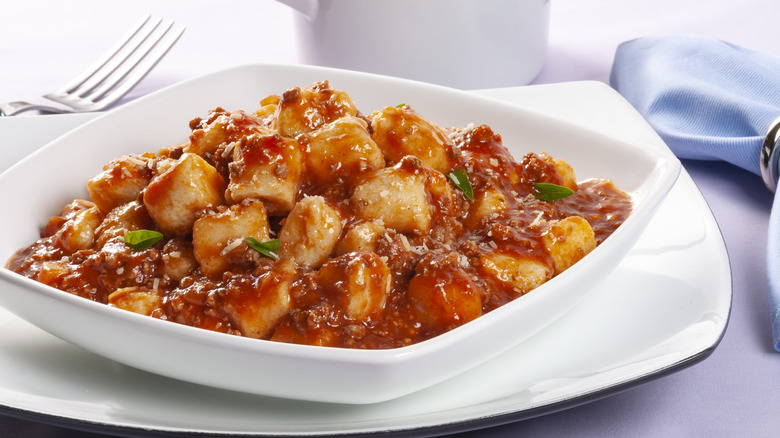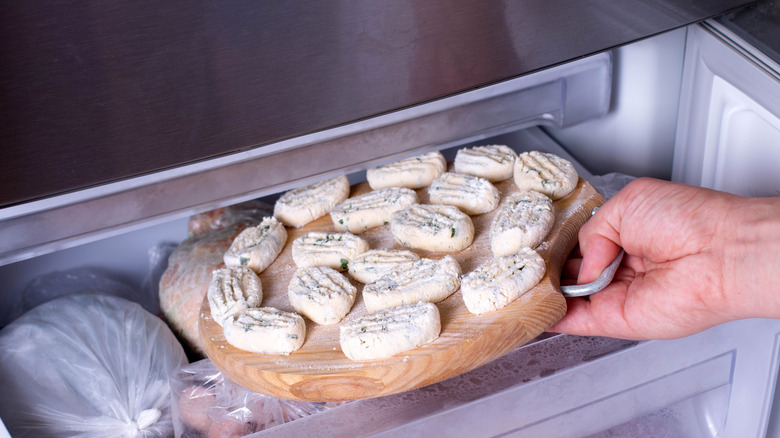15 Mistakes Everyone Makes With Homemade Gnocchi
Gnocchi — the little potato pasta that feels like a bite of sunshine with each tiny puff. These pasta aren't shaped like their long and skinny fettuccini cousins or round rigatonis, nor are gnocchi made with the same ingredients as other traditional types of Italian pasta. According to the Amaro Bistro, gnocchi originated in Northern Italy where the climate was more suitable to growing potatoes, which is the foundation of gnocchi, instead of the wheat used in most Italian pasta types. On a textural level, using potatoes for a base of the pasta adds a pillowy, airy element.
In recent years, cooks have experimented with gnocchi to substitute starchy potatoes with sweet potatoes with a light, sweet sauce or develop alternative recipes like Trader Joe's cauliflower gnocchi, which has attracted a cult-like following. And while pre-packaged gnocchi is arguably much easier than preparing your own (seriously, just boil, toss with a sauce, and have dinner on the table in less than 20 minutes), there is just something more satisfying about making your own. Here are some of our tips for making the best gnocchi at home.
Choosing the wrong type of potato
There are a ton of different potatoes out there, so how do you even come remotely close to picking the "right" kind for your gnocchi? If you're looking for a potato variety, you should aim for a high-starch potato rather than a waxier potato. The russets are a high-starch, oval tuber with a rough brown skin and pale or light yellow interior. The qualities of this potato, along with its size for easy handling, make it the perfect potato type for gnocchi. If you're looking for potatoes with a stronger flavor, you can use Yukon gold potatoes, instead. While the Yukon gold has a bit more waxiness than a russet, the Yukon gold is less likely to gum up when boiled. The resulting texture is pillowy, and the pieces will crisp up if you decide to pan-fry the gnocchi before saucing. There are some types of potatoes you should avoid as well — like the waxy red potato or tiny fingerling.
Boiling the potatoes
Although it might be tempting to boil and mash your potatoes to make homemade gnocchi, this method is not always the most foolproof way to prepare your potatoes. Instead of boiling the potatoes, chef Nigella Lawson recommends baking the potatoes instead of boiling. Boiling the potatoes in water, even if the skin is left on the potato, invites the opportunity for moisture to encroach into the tuber. In turn, you'll have to add more flour to your gnocchi to firm up the dough and make it easier to work with when you're ready to form your potato pillows.
Instead of boiling your potatoes, you should roast the potatoes in the oven with the skins on. You'll need to bake the potatoes for about an hour at 425 degrees until softened; larger potatoes with more flesh may require more time in the oven. Once the potatoes are softened (you can test this with a fork), remove the tray from the oven and move forward — resting assured that your potatoes won't be soupy when you combine the other ingredients.
Using the wrong implement to mash your potatoes
When you're preparing your potatoes for gnocchi, how should you go about removing the skin? We recommend sticking to a potato ricer or food mill to grind your potato into tiny pieces before mixing it with the rest of your ingredients. Your potatoes should be fully cool (or at least cool to the touch) before you move to this step. Cool potatoes will allow you to remove the skin without scalding your fingers. We use a potato ricer, food mill, or a grater for our potato gnocchi because it allows more air to circulate into the potato shreds, per The Deblicious. Mashing the potatoes with a conventional masher, or whipping with a hand mixer, results in potato gloop, especially because you'll have to add more flour to counteract the moisture from the mashing.
If you don't have a ricer or a grater handy, you can use a fork. If you opt for this method, avoid over-mashing the potatoes and focus on regularly flipping and turning the potatoes for maximum air flow.
Using the wrong type of flour
Flour is an important product in making almost any kind of pasta. Homemade Italian egg pastas (like fettuccini) are made with 00 flour instead of all purpose flour. 00 flour is made with super soft durum wheat and is ground finely for the smoothest possible texture, which is good for even dense pasta types like gnocchi. 00 flour has similar gluten concentration to all-purpose flour, so you won't have to worry about altering the structure of the pasta by over-kneading it more than if you used all-purpose flour (via FineDiningLovers).
According to MasterClass, substituting 00 flour for all-purpose flour can impact the hydration of the dough because the particle size of the wheat particles absorbs less water than all-purpose flour. Therefore, although your gnocchi might have a more delicate structure with the use of 00 flour, you may have to modify the liquids used otherwise in the recipe.
Adding too much flour all at once
When baking, you should always stick to adding flour to the mix gradually. It is very easy to add too much flour to gnocchi dough, which can make these dumplings glutinous, gummy, and sticky. If you dump all of the flour into your gnocchi dough at once, you won't have the same texture as a gnocchi that has just enough flour to bring it together.
As a general rule of thumb, you should use ¼ cup of flour for each pound of potatoes to start with. Once you hand mix the flour into the gnocchi dough, it should remain slightly sticky. You can add more flour to your hands and the kitchen surface to reduce how much mashed potato you'll have to pull off your fingers — without having to risk making your dough too rubbery. You can also sift flour into your dough for better aeration.
Thinking you always have to use eggs
Eggs are an important ingredient in the kitchen for baking and cooking because of their as a binder. But, do you always need to use gnocchi to make eggs?
Historically speaking, gnocchi recipes from the Venetian regions of Italy use eggs for binding while traditionally gnocchi from the Piedmont region does not (via Country Trading Co.). Adding eggs to gnocchi can add a bit of color to your gnocchi, but adding eggs to your mix isn't always the best idea. You'll have to add extra flour to absorb the moisture from the egg, and you might overpower the delicate flavors in the gnocchi with the flavor of the egg. Plus, if you pair your gnocchi with the perfect kind of sauce, you won't have to worry about flavoring the gnocchi ahead of time. If you want Venetian gnocchi, you can add eggs, or keep it simple and go eggless.
Not trying to add ricotta
Ricotta gnocchi are in a category of its own, called gnudi. According to Buffalo News, ricotta's soft, milky flavor elevates the flavor profile the more traditional gnocchi ingredients including the potato and the flour. Sheep's milk ricotta has a more acidic taste than dairy-based ricotta, but both are viable options per Buffalo News.
In Italian cooking, gnudi usually include both ricotta and spinach. Buffalo News recommends that if you go the route of adding a bit of green to your gnudi that you take the extra step of cooking and chopping or pureeing the spinach. If you leave too much water in a liquid-rich green like spinach, you can expect your gnudi to be too wet and not hold when you cook it. Like most gnocchi recipes, you should not be afraid to be generous with the parmesan; the addition of this dry cheese will only amplify the flavors of the ricotta and the earthiness of the spinach.
Overworking the dough
Gluten is not always your friend when you're making gnocchi. Gluten is one of two proteins commonly found in wheat-based products. Glutenin, which is also what the protein is known as, is the primary elastic agent in dough. Without the addition of gluten (or similar compounds), your gnocchi would come out firm, dense, and sad. Too much gluten — or worse, overworked gluten — will cause your gnocchi to resemble the texture of new tires.
When you are kneading your gnocchi dough after adding flour (gradually, we should note), you should be very cautious not to over-handle the dough and cause the gluten to develop too much. When you start working the dough, try to gently fold in the flour with a hard spoon or a scraper to mix the ingredients together gently. Then, switch to a firmer hand to knead the ingredients together. If you are familiar with hand-kneading bread, you might have a predisposition to pulling, stretching, and folding the dough. This will cause the fragile gluten structure to over-develop. Instead, stick to folding the dough — like laminating butter — to incorporate all of the ingredients rather than overworking the dough.
Not using a ridge paddle to shape your gnocchi
One of the most unique parts about gnocchi is its ridged shape. The primary purpose of this forming technique creates a greater surface area on the dumpling, which in turn makes it a little easier for the sauce to stick to the dough.
Traditionally, gnocchi is pressed using a board called a rigagnocchi or the tines of a fork. When these shapes are formed, the gnocchi is either ridged against the bottom of the rigagnocchi or by rubbing the corner of the gnocchi with your thumb. This motion creates a small sauce pocket. While this tip is not essential to creating an edible gnocchi by any means, it is beneficial for increasing the saucy flavor that the gnocchi is immersed in. When you are pressing the indentation, you should only press down enough to leave a slight pocket — not enough to split the dough into two pieces.
Forgetting to toss your gnocchi in flour
Remember how we said it was important to be frugal with the flour when you're working with gnocchi? That same rule doesn't apply when you're trying to make form gnocchi and prevent the pieces from sticking to one another. You should use ample flour on both your hands and the gnocchi while you are adding the ridges or the dimple. If you wait too long to cook your gnocchi, you will find that the dough is more difficult to work with and is more likely to stick to other gnocchi before you cook the dumplings.
According to the Washington Post, you can use a pastry brush to dust off the flour from the gnocchi before adding the dumplings to the water. This will prevent the gnocchi water from becoming too cloudy so that you can't see when the gnocchi are ready to be removed from the pot.
Only boiling the gnocchi
Pasta is supposed to be soft and al dente, but we would like to argue that gnocchi tastes a whole lot better if it's crisped up in the air fryer or oven instead. Boiling store-bought gnocchi tends to cause the dough to become a chewy mess, which is why we recommend cooking them in a pan, oven, or air fryer. The same premise goes for homemade gnocchi, but you run less of a risk of gumminess if you stick to the typical boiling method.
If you want a crispy gnocchi (which tastes just as delicious with sauce), you should add the gnocchi to a pan with a little bit of oil and pan-fry the gnocchi until the gnocchi is browned on the outside. Keep an eye on the stove to rotate the gnocchi, as needed, so that each side of the gnocchi develops a crisp, golden-brown color.
Pairing sauces without care
Gnocchi is versatile in pairing with sauces, but that doesn't mean that you can't just add just any sauce to the dish you spent so much time cooking and forming. According to the Pasta Project, gnocchi has regional variations for sauces. In Piedmont and Lombardy, gnocchi are tossed with butter and Parmigiano Reggiano cheese and baked. Venetian gnocchi are prepared with a thin tomato sauce while pesto sauce is a favorite for Liguria, says Pasta Project.
Our personal favorite for gnocchi has to be either pesto or sage butter. Pesto is one type of pasta sauce made with a bit of oil that helps the sauce stick to the ridges. Variations on homemade pesto sauce can include pistachios or walnuts rather than the traditional pine nut variety. Our sage butter sauce is the perfect pairing for purple potato gnocchi and gets a boost of flavor from the addition of white balsamic vinegar.
Cooking the gnocchi and sauce seperately
For a weeknight dinner, we highly doubt that planning an elaborate dish with a ton of pots and pans to wash are in your cards. Instead, save a bit of time and add a more flavorful upgrade to your gnocchi by cooking it in the sauce you're serving it with. You won't have to wait for the water to come up to a boil, nor will you have to worry about washing yet another pot. Cooking the dumplings in the sauce will amplify the flavors of your sauce, as well.
There are some precautions you should take before dumping your carefully crafted gnocchi into a pot of warmed tomato sauce from the jar. Jarred tomato sauces are particularly thick and not conducive to cooking any time of pasta in. Instead, thin out your pasta with a couple splashes of stock or stick to a sauce recipe that is specifically designed to be made in one pot.
Drowning your gnocchi in sauce
Do you prefer the gnocchi or the sauce more? Your answer, as well as your feelings about dipping the accompanying bread into the leftover sauce, may dictate how much sauce you decide to eat your gnocchi with. But, we argue that you should avoid adding too much pasta sauce to drown out the flavor of your gnocchi. De Lallo recommends sticking to the ratio of 1 and ½ cup of tomato sauce for each pound of pasta. The ratio for oil-based sauces is slightly less; 1 cup of oil-based sauces per each pound of pasta, says De Lallo.
These ratios are ideal for having just enough sauce, but not too much to allow your gnocchi to float in. For optimal sauce sticking, you should also rinse the starch off your gnocchi with water after cooking. Like other pasta types, you can reserve a bit of the pasta water for thinning out tomato-based sauces or improving the binding potential of oil-based sauces.
Keeping your gnocchi in your fridge
The primary storage method for uncooked gnocchi is your freezer. You should first flash-freeze your dumplings by placing the gnocchi on a baking sheet before removing the pasta from the pan and adding the dumplings to a bag. If you go with the option of adding your raw gnocchi to the refrigerator, you will likely face the repercussions of your pasta becoming too wet and sticky as the water leaches out from the dough, as well as the dough sticking to every surface you try to put it on. Plus, potatoes oxidize and turn gray as the raw potato ages, so you could face some unappetizing color changes in your gnocchi.
If you have already cooked gnocchi, Pantry and Larder recommends sticking to your refrigerator. After you remove the gnocchi from the cooking liquid, the website recommends adding the dumplings to an ice bath to stop the cooling process before draining the water and tossing with oil to prevent sticking. This method lasts a measly two days in the refrigerator and can be reheated with your favorite sauce on the stove.
